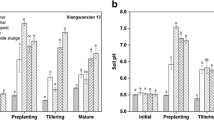Abstract
When grown on Cd-contaminated soil, rice typically accumulates considerable Cd in straw, and which may return to the soil after harvest. This work was undertaken to assess the pollution risk of Cd associated to the Cd-contaminated rice straw after incorporating into an uncontaminated soil. With the Cd-contaminated rice straw added at 0, 1, 2, 3, 4 and 5 % (w/w), an incubation experiment (28 days) with non-planting and a followed pot experiment sequent with two planting (rice and Chinese cabbage, transplanted after 28-day incubation) were carried out to investigate the changes of soil Cd speciation and phytoavailability. The results indicated that the Cd-contaminated rice straw addition significantly increased soil pH and dissolved organic carbon during the 28-day incubation. For the high availability of Cd in contaminated rice straw, diethylenetriaminepentaacetic acid (DTPA) extractable Cd significantly increased, and the percentages of acetic acid extractable and reducible Cd in soil significantly enhanced after the addition of Cd-contaminated rice straw. However, the Cd-contaminated rice straw addition inhibited the rice growth and induced the decrease of Cd in rice grain and straw by 12.8 to 70.2 % and 39.3 to 57.3 %, respectively, whereas the Cd contents increased by 13.9 to 84.1 % in Chinese cabbage that planted after rice harvest. In conclusion, Cd associated with Cd-contaminated rice straw was highly available after incorporating into the soil, and thus the Cd pollution risk via the Cd-contaminated rice straw incorporation should be evaluated in the Cd-contaminated paddy region.





Similar content being viewed by others
References
Bai Y, Gu C, Tao T, Chen G, Shan Y (2013) Straw incorporation increases solubility and uptake of cadmium by rice plants. Acta Agr Scand B-S P 63:193–199
Cui YS, Du X, Weng LP, Zhu YG (2008) Effects of rice straw on the speciation of cadmium (Cd) and copper (Cu) in soils. Geoderma 146:370–377
Cui YS, Fu J, Chen XC (2011) Speciation and bioaccessibility of lead and cadmium in soil treated with metal-enriched Indian mustard leaves. J Environ Sci 23:624–632
Gee GW, Bauder JW (1986) Particle-size analysis. In: Klute A et al (ed) Methods of soil analysis. Part 1. Physical and mineralogical method. Second ed. Madison, pp 383–412
Jones DL, Willett VB (2006) Experimental evaluation of methods to quantify dissolved organic nitrogen (DON) and dissolved organic carbon (DOC) in soil. Soil Biol Biochem 38:991–999
Katoh M, Murase J, Sugimoto A, Kimura M (2005) Effect of rice straw amendment on dissolved organic and inorganic carbon and cationic nutrients in percolating water from a flooded paddy soil: a microcosm experiment using 13C-enriched rice straw. Org Geochem 36:803–811
Li M, Tian X, Liu RZ, Chen WL, Cai P, Rong XM, Dai K, Huang QY (2014) Combined application of rice straw and fungus Penicillium chrysogenum to remediate heavy-metal-contaminated soil. Soil Sediment Contam Int J 23:328–338
Lindsay WL, Norvell WA (1978) Development of a DTPA soil test for zinc, iron, manganese, and copper. Soil Sci Soc Am J 42:421–428
Ministry of Environmental Protection P.R.C. and Ministry of Land and Resources P.R.C. (2014) Report on soil pollution in China. http://www.sdpc.gov.cn/fzgggz/ncjj/zhdt/201404/t20140418_607888.html
Mossop KF, Davidson CM (2003) Comparison of original and modified BCR sequential extraction procedures for the fractionation of copper, iron, lead, manganese and zinc in soils and sediments. Anal Chim Acta 478:111–118
Olsen SR, Somers LE (1982) Phosphorus. In: Page AL, Miller RH, Keene DR (eds) Methods of soil analysis, vol 2. Soil Science Society of America, Madison, pp 403–448
Perronnet K, Schwartz C, Gerard E, Morel JL (2000) Availability of cadmium and zinc accumulated in the leaves of Thlaspi caerulescens incorporated into soil. Plant Soil 227:257–263
Rosen V, Chen Y (2014) The influence of compost addition on heavy metal distribution between operationally defined geochemical fractions and on metal accumulation in plant. J Soils Sediments 14:713–720
Shi J, Pan GX, Zhang NM (2013) Effect of cadmium stress on Cd and Zn uptake and accumulation of different cultivars of hybrid rice. Acta Sci Circumst 33:2901–2910
Vázquez S, Carpena RO, Bernal MP (2008) Contribution of heavy metals and As-loaded lupin root mineralization to the availability of the pollutants in multi-contaminated soils. Environ Pollut 152:373–379
Wu L, Li Z, Akahane L, Liu L, Han C, Makino T, Luo Y, Christie P (2012) Effects of organic amendments on Cd, Zn and Cu bioavailability in soil with repeated phytoremediation by Sedum plumbizincicola. Int J Phytoremediation 14:1024–1038
Zhang XL (2008) Physiological mechanisms of Cd hyperaccumulation by the ASME of Sedum alfredii H. and its regulation. Dissertation, Zhejiang University (In Chinese)
Zhao BH, Zhang HX, Xi LL, Zhu QS, Yang JC (2006) Concentrations and accumulation of Cadmium different organs of hybrid rice. Chin J Rice Sci 20:306–312 (In Chinese)
Zhu QH, Huang DY, Liu SL, Zhang WJ, Su YR, Wu JS (2005) Status and prospect s of crop straw comprehensive utilisation in hilly red soil region. Chin J Ecol 24:1482–1486 (In Chinese)
Zhu QH, Huang DY, Zhu GX, Ge TD, Liu GS, Zhu HH, Liu SL, Zhang XN (2010) Sepiolite is recommended for the remediation of Cd-contaminated paddy soil. Acta Agric Scand Sect B Plant Soil Sci 60:110–116
Zhu QH, Huang DY, Liu SL, Zhou B, Luo ZC, Zhu HH (2012a) Flooding-enhanced immobilization effect of sepiolite on cadmium in paddy soil. J Soils Sediments 12:169–177
Zhu QH, Huang DY, Liu SL, Luo ZC, Zhu HH, Zhou B, Lei M, Rao ZX, Cao XL (2012b) Assessment of single extraction methods for evaluating the immobilization effect of amendments on cadmium in contaminated acidic paddy soil. Plant Soil Environ 58:98–103
Acknowledgments
This work was supported by the National Key Technologies R&D Program of China (2012BAD05B06), the National Natural Science Foundation of China (41101300, 41371318) and Natural Science Foundation of Hunan Province (13JJ4113).
Author information
Authors and Affiliations
Corresponding author
Additional information
Responsible editor: Stuart Simpson
Rights and permissions
About this article
Cite this article
Wang, S., Huang, DY., Zhu, QH. et al. Speciation and phytoavailability of cadmium in soil treated with cadmium-contaminated rice straw. Environ Sci Pollut Res 22, 2679–2686 (2015). https://doi.org/10.1007/s11356-014-3515-2
Received:
Accepted:
Published:
Issue Date:
DOI: https://doi.org/10.1007/s11356-014-3515-2




